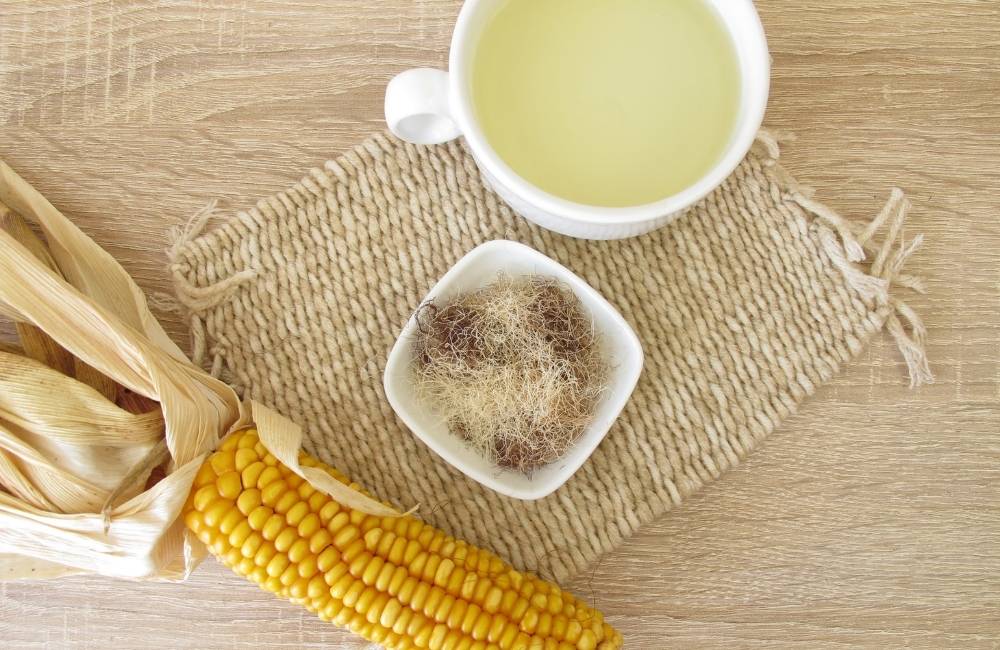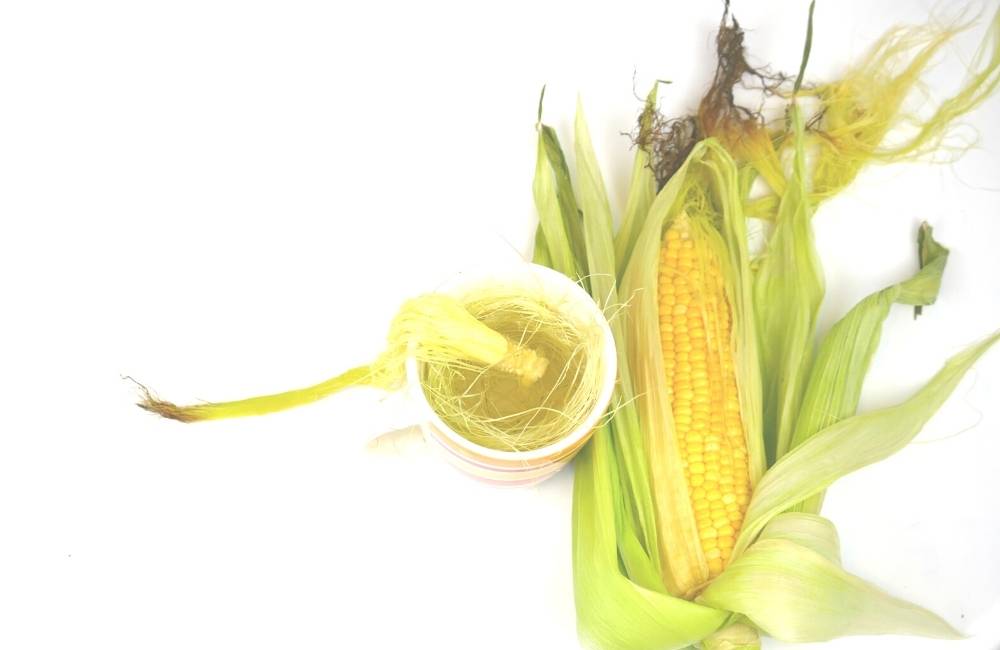When it comes to hair care, there are a lot of different products and methods out there. And while corn silk doesn’t immediately spring to mind, it can actually be a great option for improving your hair care game.
That’s right – corn silk has some serious hair-growing power. This is exactly why it has been used in traditional Chinese medicine for centuries.
So, if you’d like to boost your hair health naturally, these cute-looking threads called corn silk may be worth a try. We’re here to explain everything you need to know about using corn silk for hair – from what it is and how it works to how long it takes to work.

Contents
What is corn silk?
Cobs of corn contain long, silky yellow strands called corn silk or corn hair. These strands, grown from ear of corn, are actually the corn plant’s female reproductive organs, also known as silks. There are about 20-30 silks per cob, each about 6-12 inches long.
Corn silk, aka stigma maydis, is a pretty nifty herb! It’s used by the traditional Chinese and Native Americans to treat all sorts of diseases, and many parts of the world, including Turkey, the United States, and France, use it as traditional medicine.
You probably didn’t know that these yellowish, silky threads are full of nutrients and antioxidants that pack a powerful hair treatment punch.

The Benefits of Corn Silk for Hair Growth
How does corn silk help with hair growth? Although there are no direct scientific studies about the hair benefits of corn silk, the herb contains nutrients that may have the potential to improve hair:
Sitosterol
A plant steroid that blocks the production of DHT, a hormone that contributes to hair loss. A small study found that 60% of men with signs of male pattern baldness who received beta-sitosterol (a type of sitosterol) with saw palmetto showed improvements in hair growth.
Stigmasterol
Another plant steroid that stimulates hair follicles by restoring antioxidants to the hair shaft, along with blocking off DHT. A study found that stigmasterol can stop the activity of 5AR1 (the enzyme that converts testosterone to dihydrotestosterone (DHT) and act as an effective hair growth supplement.
Saponins
Saponins are known for creating foamy lathers—this is why they purify the scalp naturally by removing dirt and buildup. The anti-inflammatory compound can help soothe the scalp and reduce dandruff. Moreover, saponins stimulate blood flow to the scalp, promoting a healthy ground for growth.
Tannins
As organic compounds, tannins are easily absorbed by hair keratin proteins, making hair a little stronger. As antioxidants and anti-inflammatory agents, they may shield hair from damage, especially after excessive coloring or heat treatment. A lot of hair straightening and smoothing treatments use tannins for extra shine.
Flavonoids
Corn silk flavonoids have been shown to have positive effects on hair, like promoting growth, protection against hair loss, and boosting strength. Lutein, a powerful antioxidant, is also found in corn silk, which gives additional protection from UV damage.
Silica
An essential trace mineral found in corn silk, often touted as a natural remedy for healthy hair. While silica does not directly promote hair growth, it strengthens and adds elasticity to the hair, preventing shedding. As a result, your hair follicles receive essential nutrients. Bonus: it’s also good for your skin and nails.
Vitamins
A humble herb full of nutrients can work wonders for your hair! Corn silk is an incredible source of vitamins like A, C, and E.
- Vitamin A: Produces sebum, which hydrates hair
- Vitamin C: Builds collagen, which makes hair stronger
- Vitamin E: Protects hair against damage
- B vitamins: Increase keratin production, which strengthens hair
Is corn silk edible?
Yes, corn silk is edible. It can be used in a variety of dishes, including soups, stews, and salads. It has a slightly sweet taste, is high in fiber and makes a good tea.
How to Use Corn Silk for Hair Growth
Tea
Drinking corn silk tea can nourish the hair from the inside out.
- Grab a cup of water and bring it to a boil.
- Stir in one tablespoon of fresh or dried corn silk and let it steep for 10 minutes.
- Strain the tea and sweeten it with honey or sugar if you like. You can drink it hot or iced once or twice a day.
Avoid drinking corn hair tea right before you go to sleep. For kids, the recommended dosage is one cup a day.
Hair rinse
- Steep a small handful of corn silk in boiling water for about 10 minutes.
- Once the corn silk has infused the water, strain it and massage the resulting liquid into your scalp.
- Leave it on for about 30 minutes before rinsing it out. You can do this treatment once or twice weekly for the best results.
Deep hair conditioner
- Mix one tablespoon of corn silk with half a teaspoon of olive oil.
- Combine all the ingredients well to ensure a good blend.
- Apply this mixture to your hair and scalp.
- Let it sit on your hair for 10-15 minutes.
- Rinse it out.
Shampoo
Add a few tablespoons of corn silk to your favorite shampoo. Massage it into your scalp and hair, and then rinse out.
Hair mask
- Combine corn silk and plain yogurt in equal parts.
- Let the mixture sit on your hair and scalp for 20 minutes.
- Rinse out with warm water.
Corn silk oil
- Simmer corn silk in olive oil for 10 minutes. Or, get corn silk extract or oil at health food stores.
- Gently massage the oil into your scalp.
- Once you’ve left it on for 30 minutes, shampoo normally.
Give one (or all!) of these corn silk hair growth remedies a try and see for yourself how effective they can be!
Results you can expect
A few weeks after using corn silk for hair growth, your hair should be thicker, shinier, and fuller. An affordable alternative to expensive hair loss treatments, this natural remedy is safe to use on all types of hair.
How often should you use corn silk for hair growth?
Depends on your hair type and needs. If you have oily hair, you may need to use corn silk daily. If you have dry hair, you may only need to use it once or twice a week.
Is there any risk of side effects?
When applied topically and consumed moderately, there are no reported side effects of corn silk. However, consuming it in a larger amount or more than 3 cups a day may result in these side effects:
- A drop in blood potassium levels
- Allergies, skin rashes, and itching if you’re allergic to corn
- May affect blood sugar levels in diabetics
- Possibly even lowers blood pressure
If you plan on taking corn silk along with these medications, there can be an interference:
- Diuretics
- Low or high blood pressure medications
- Diabetes medicine
- Anti-inflammatory drugs
- Blood thinners
Even though corn silk is safe for those pregnant or breastfeeding when used in the amounts normally found in food, it’s still best to talk to your healthcare provider.
Bottom line
While many think of corn silk as nothing more than the stringy stuff that gets stuck in your teeth, this humble plant actually has a lot to offer for your hair.
The claim that corn silk promotes hair growth lacks direct scientific evidence and of course, more research is needed. Despite this, some people swear by it and say it has helped them grow longer and thicker hair.
If you plan to consume corn silk for hair growth, consult your doctor first to confirm it’s safe for you. To start this haircare treatment the best way, apply it topically rather than brewing tea.
Thank you for sharing this info. I forgot about cornsilk, I saw dried corn silk in a store and I looked up cornsilk as a hair growth remedy after reading your blog
I’m so happy to get this, but please do you have to wash it before using it for tea or for your hair
Do l have to wash the corn silk before l use it for tea?
Thank you
Can I use the same cornsilk next time?
The benefits of corn silk for hair growth surprised me. The corn silk tea sounds great, I’m definitely going to try it.
Healthy hair is key. Keep your hair clean, deep condition it, and use styling products that protect it from heat damage. A balanced diet and regular trims also help.